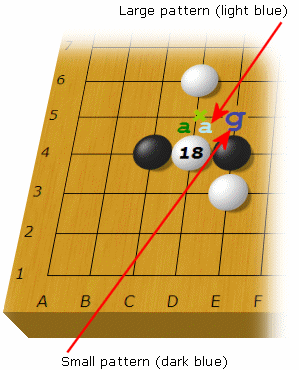
Interpreting Statistical Pattern Urgency
Understanding Statistical Move Likelihood
MoyoGo's Pattern Example Expert knows the "Statistical Move Likelihood" of almost 17 million of the most commonly occuring Go patterns (color-, rotation- and mirror-invariance are taken into account, so all those patterns are really different). Patterns can have 12 different sizes (from very small much larger than the board) A pattern is defined as a one of twelve size-classes of an unique configuration of certain stones, chain liberties, chain length, distance to the board edge and the ko-status. Patterns have a center point, which is the "to-move-on" point.

Statistical Move Likelihood is not "frequency"
The Statistical Move Likelihood for the 17 million patterns Moyo Go knows about has been pre-calculated as follows:
How often the pattern (with empty center point) occurred in all games
-------------------------------------------------------------------------------- x 100%
How many turns the average player waited to play on the pattern's center point
This means that when the percentage is 33.33%, that on average, the average player would wait two moves before he/she would play on that pattern (and would play there on the third occasion). A percentage of 100% means that always, as soon as that pattern appeared on the board, a player immediately played there. A percentage of 10% means that nine out of ten cases, a player preferred to play somewhere else instead.
Statistical Move Likelihood is not a simple database statistic
A 10% likelihood does not mean that the move occurs in 10% of games, and not that 10% of the players played it, and not that there are 10 games with that move! Some patterns do not have corresponding games in their database, because "Move Likelihood" data is based on more games than come with Moyo Go studio, for Moyo Go should also "learn" patterns that are responses to bad move patterns.
More details about the Pattern expert can be found in this PDF file (needs Adobe Acrobat Reader).
Copyright 2002-2009, MoyoGo Studio / Frank A. de Groot